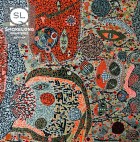In a story in which space tends to be regular and delineated, even when it is hypothetical (those parking spots surrounded by empty spots, the invisible barrier that the shopping carts can’t pass), the “wonky” cartwheel that messes up “… what would’ve been, in a perfect world, very pretty symmetry,” feels significant as the story unfolds. I’m tempted to imagine that everything in the story comes out of that observation of botched symmetry but am much more interested, if you are willing, to hear what it comes out of for you ….
Botched symmetry is it exactly. There’s the old idea that beauty depends on symmetry. And maybe it does. But say you’re walking along and you spot a daisy. A crayon-yellow center, the perfect number of shapely white petals. You look closer, though, and the petals are a little ragged. One’s got a bite taken out of it. And the center is, like, cumulatively yellow, but there’s a lot of brown, dead-looking shit in there, too. Beauty kind of depends on how close you’re willing to look.
Maybe symmetry does exist like mathematically or whatever, but, really, there’s no such thing. It’s a made-up thing. People glom onto the idea of it, I imagine, for the same reason they glom onto order, or the idea of order—this is this, that goes there, this is beautiful because, etc.
The character is constantly observing and criticizing, testing the artificiality of the limits set by the adult world and calling bullshit on the easy explanations. Or that’s how I see her.
Like her, I went to a Christian middle school, whose teachers were wildly unqualified to teach their subjects. Parents and teachers loved to quote scripture at me as instruction. When I was her age, I remember my dad found something I’d written and was upset by it. By way of admonishment, he paraphrased Phillipians 4:8—whatever is right, pure, lovely, admirable, good, praiseworthy, or excellent, he told me, think about those things. Symmetrical things. I was pissed off for years about that. If I only thought about the pretty stuff, was I just supposed to ignore everything else?
This story is funny! And (rather than but) the humor tends to be sharp, more than a little serrated. “Blink your eyes and voila. Or as Pastor Wible says, viola.” Can you talk a little about how you settled on just the right blade for your narrator’s voice? Did you have any models in mind?
This story is excerpted from a novel-in-progress called The Valentines, so I’ve had a lot of time and error to develop her voice beyond this story.
Do you shop at Walmart? I ask because the story gives the impression that you have been in those parking lots and didn’t just watch a couple of YouTube videos or read a couple of Scott McClanahan stories. Then again, because I read this blind I didn’t know your gender and lazily assumed I was reading work written by a woman, no doubt because lane swerving around experience and gender have become ever more rare ….
I don’t shop at Walmart, but when I was a teenager, my friends and I, if we could catch a ride, would spend a lot of time there, mostly at night. Waco, Texas, in the mid-nineties was a boring place to live, and when you’re fourteen, poor, and the Internet hasn’t been invented yet, Walmart can be high entertainment. Huge families coming in from the country, loading their carts with a month’s worth of groceries, yelling at each other, making scenes. Some frazzled mom spanking her kid in the middle of the cosmetics aisle. We made up stories about the people we saw and tried to outdo each other.
Also, we shoplifted. Both those things, telling stories and stealing, require you to do more than just look—you have to pay attention to everything. Whether it’s a security guard in your periphery or a guy with his baby’s footprint tattooed on his neck, it’s all important. For better or worse, shoplifting and making fun of Walmart people was probably way more formative for me than, say, school or church.
The story is full of great, precise descriptions of physical action, which often serve to underscore a line of thought or vector of emotion. E.g.,“When she moves, her coat makes her sound like my baby brother in his diaper. She grabs at me, but her arms are too short. I cram myself against the door so she can’t smack me or snatch the cigarette ….” How much do you rework your sentences to get at the description of the worlds you are building that feel just right?
I tend to think more in terms of paragraphs than sentences. I’ll write a paragraph, stare off into space, smoke a cigarette, and then write a different version of the same paragraph. Sometimes three or four different versions, other times two or three pages of different versions. I tinker, cut and paste, reorder the sentences, and often, it’s when I’m pretty much sure I’ve ruined whatever idea I was trying to get at that I catch some glimpse of the way I want it to be. And then I can move onto the next paragraph. As far as process goes, I can’t say I’d recommend it.
So which/what came first?
Pretty sure the story came out of a prompt in a grad workshop at Ohio State, but I can’t remember what the prompt would’ve been. I’d always wanted to write a story about shoplifting, but, like most story ideas, it became something else when I actually started writing it.



 The SmokeLong Grand Micro Contest (The Mikey) is now an annual competition celebrating and compensating the best micro fiction and nonfiction online.
The SmokeLong Grand Micro Contest (The Mikey) is now an annual competition celebrating and compensating the best micro fiction and nonfiction online.